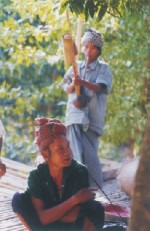Rights Investigation
CHT:
Protect the rights of the internally displaced person
R M Faizur Rahman
The indigenous internally displaced person (IDPs) are among the most disadvantaged and vulnerable people in the Chittagong Hill Tracts. So far humanitarian responses have fallen far short of adequate protection and rehabilitation of this group of people. These IDPs are vulnerable because they are neither supported by the Government nor fall under any defined international protection mechanism. They have experienced endless development obstacles caused by conflict, violence, human rights violations, political exclusion and displacement itself; contributing to their situation of impoverishment and marginalisation.
These were some of the observation made by Jessica Skinner, a former RMMRU-DRC fellow, at a presentation of her paper on Internal Displacement of Indigenous Communities in the CHT and Rights-based Approaches to Rehabilitation at the two day symposium on Learning from the Marginalised, organised by Young Researchers' Forum of Refugee and Migratory Movements Research Unit of the University of Dhaka. The study was conducted and the symposium was held recently under the auspices of the Development Research Centre on Migration, Globalisation and Poverty based at the University of Sussex.
 Skinner pointed out that human rights and displacement are quite related issues. So in rehabilitating displaced people rights based approach should be taken into account. Policies articulated must also be sensitive to the differences that exist between and within communities and settlements. In Babu para, Malachara, the IDPs are all Chakmas and the original occupants are all Marmas. At these sites only the Marmas own cultivatable land, but most of the internally displaced Chakmas are government workers, two were headmen and three owned their own business, while an unspecified number of families were homeless. The distinction between IDPs and the host population in terms of socio-economic needs are clearly different and these differences need to be recognised in any rehabilitation programmes, the presenter argued.
Skinner pointed out that human rights and displacement are quite related issues. So in rehabilitating displaced people rights based approach should be taken into account. Policies articulated must also be sensitive to the differences that exist between and within communities and settlements. In Babu para, Malachara, the IDPs are all Chakmas and the original occupants are all Marmas. At these sites only the Marmas own cultivatable land, but most of the internally displaced Chakmas are government workers, two were headmen and three owned their own business, while an unspecified number of families were homeless. The distinction between IDPs and the host population in terms of socio-economic needs are clearly different and these differences need to be recognised in any rehabilitation programmes, the presenter argued.
In order to effectively implement sustainable rehabilitation Skinner also recommended some measures for implementing rights based approach to IDP rehabilitation in the CHT. These include identifying the profiles, localities, needs and desires of the IDPs and their experiences of rights violations. Rations in the region need to be provided to members of all communities. IDP communities living in reserved forests are also to be recognised. Training sessions should be given to government officers, politicians, non-state actors, army personnel, international donors, NGOs and IDPs on not only the Guiding Principles on Internal Displacement, but also the situation of internal displacement in Bangladesh to counter the gaps and misinformation.
The problem of internal displacement is not simply a problem that is confined to the CHT, but is rife throughout Bangladesh especially in the remoter areas, where economically marginalised and minority communities are often the victims of human rights abuse and discrimination.
Although many, including local and national NGOs still believe that the situation cannot be settled without the removal of the Bengali settlers from the region, it also has to be recognised that the majority of the Bengali settlers are there to stay, the study reckoned. Despite international offers of financial and logistical assistance for the resettlement of all Bengali settlers brought to the CHT under government settlement programmes, the Government has not acted to carry out its obligation as defined in the 1997 peace accord. Based on a comprehensive and independent study of the Bengali settler's needs and desires, a compromise needs to be worked out between the Government and the PCJSS on resettlement outside of the CHT. The physical, political, economic and cultural marginalisation of the indigenous communities and particularly those displaced within the region need to be addressed and as part of the long process towards peace; and cross-community participation and understanding needs to be encouraged, the study noted.
The author is working with RMMRU.